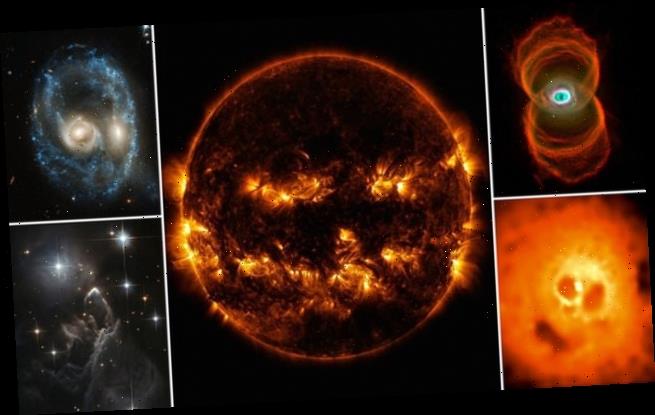NASA celebrates Halloween with series of spooky images from space – including ‘glowing skull’, ‘witch’s face’ and ‘evil eye’
- A collection of photos seeming to show freaky phenomenons have been put together in time for Halloween
- Green glowing ghost clouds from dead stars, and a ‘witches head’ nebula are among the peculiar images
- But despite their unearthly qualities the eerie images are rationally explained by science – or at least a theory
Spooky snaps of space capture what appear to be ghoulish goings on in the abyss at the boundaries of human knowledge… just in time for Halloween.
A collection of photos seeming to show freaky phenomenons have been put together to demonstrate how all is not what it seems.
What may appear to be an ‘alien head’ when pictured through the telescope is in fact two neighbouring galaxies colliding hundreds of thousands of light years away.
While the blue ethereal outline of a witches head is in fact the dust of a dead star glowing by the light of its neighbouring star Rigel.
Despite their unearthly qualities the eerie images can all be rationally explained using science.
A Hubble Space Telescope image of the ‘Hourglass’ Nebula taken in 1996. One theory believes the hourglass shape is produced by a fast stellar wind expanding within a cloud that is expanding at a slower rate and is denser across its middle
A flaming skull appeared in the heart of the Perseus cluster of galaxies. The Perseus A, a gigantic galaxy (seen between the ‘eyes’) is being devoured by a black hole and spitting out of high-energy radiation. The image was captured by the orbiting Chandra X-ray Observatory. The dark regions are each about half the size of our milky way – 100,000 light years wide
The Hubble telescope was launched on April 24, 1990, via the space shuttle Discovery from Kennedy Space Centre in Florida.
It is named after famed astronomer Edwin Hubble who was born in Missouri in 1889.
He is arguably most famous for discovering that the universe is expanding and the rate at which is does so – now coined the Hubble constant.
The Hubble telescope is named after famed astronomer Edwin Hubble who was born in Missouri in 1889 (pictured)
Hubble has made more than 1.3 million observations since its mission began in 1990 and helped publish more than 15,000 scientific papers.
It orbits Earth at a speed of about 17,000mph (27,300kph) in low Earth orbit at about 340 miles in altitude.
Hubble has the pointing accuracy of .007 arc seconds, which is like being able to shine a laser beam focused on Franklin D. Roosevelt’s head on a dime roughly 200 miles (320km) away.
The Hubble telescope is named after Edwin Hubble who was responsible for coming up with the Hubble constant and is one of the greatest astronomers of all-time
Hubble’s primary mirror is 2.4 meters (7 feet, 10.5 inches) across and in total is 13.3 meters (43.5 feet) long – the length of a large school bus.
Hubble’s launch and deployment in April 1990 marked the most significant advance in astronomy since Galileo’s telescope.
Thanks to five servicing missions and more than 25 years of operation, our view of the universe and our place within it has never been the same.
Source: Read Full Article




